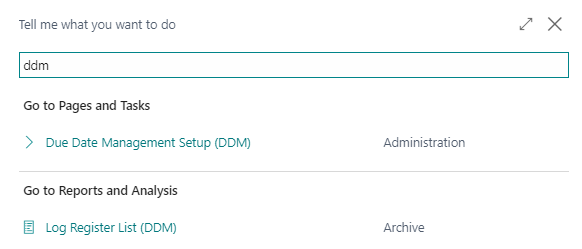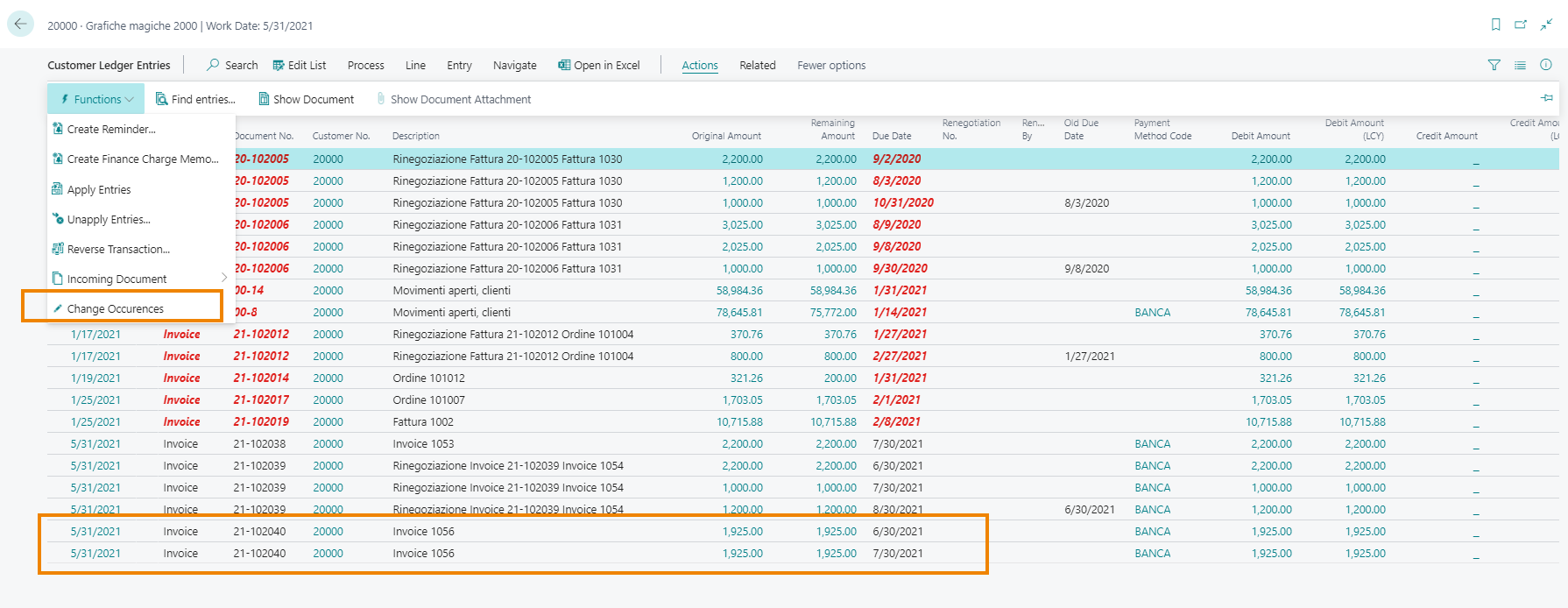Quick Guide
- Set the setup and choose which correction mode to use
- Renegotiate fully or partially open occurrences
Introduction
The Eos Solutions Due Dates Management for Italy app allows you to change the due dates of customer / vendor accounting entries, allowing you to manage the agreed installment plan.
Subscription |
|---|
|
Some features of the Due Dates Management for Italy (DDM) app require a subscription. This subscription can be activated from the SUBSCRIPTION CONTROL PANEL or directly from the notification messages that the system proposes, by clicking on the link that allows you to start the subscription wizard. For more details visit Eos Solutions website. |
Due Dates Management for Italy - SUMMARY
Press ALT + Q and digit "DDM" for a list of the features involved.

Due Date Management Setup (DDM)
Let's open the setup:

| Field | Description |
| Renegotiation Nos. | Numerator to be assigned to renegotiation entries |
| Correction Mode |
|
| Renegotiation Description | Free description for the accounting entry |
Operational steps: let's see the two options.
Reversal movements
For the "Correction mode" field present in setup, we choose the option Reversal movements.
We open the customer accounting movements for Grafiche Magiche 2000 and we select the document subject to re-negotiation (eg invoice 21-102040 with two installments, due date 06/30 and due date 07/30).

The specific page dedicated to the management of the customer occurrences opens from Actions-Functions->Change Occurrences.
The system proposes the two installments of the invoice:

| Action | Description |
| Manage->Delete | it is possible to delete one or more installments, increasing the amounts of the existing installments |
| Add Occurrency | you can add new installments with new due dates |

Through the action "Add Occurrency" we have inserted a new installment expiring on 09/30/20, reducing € 925,00 euros from the movement expiring on 07/30/20.
By executing the action "Post", the new ledger entries are modified / created.
Since we are renegotiating the second line (the system automatically proposes the previous date in the "Old due date" field). We can manually modify what is proposed if necessary.
Important |
|---|
|
- The balance must be zero - In the event that there are more due dates, the "New Due Date" of the new installment (or new installments) is proposed equal to the earliest due date of the pre-renegotiation movements; the user can in any case modify it by acting on the specific field. |
We can enter / change "Our Bank account" / "Payment Method Code".
The "Old due date" field is used to check the initial expiration and renegotiation dates of the installment.
Important |
|---|
| The Block Reason field will indicate, in the event that the renegotiation is not successful, the reason for this block. This can happen, for example, if in the setup of the Commissions CMS app it was set that an invoice cannot be renegotiated (because for example there are commissions or settlements in progress). In this case, when opening the page Change Customer Occurrences, the system will propose the Block Reason field filled in for one or more deadlines. |
After posting:

The initial invoice 21-102040 (1925,00) was closed with the "Payment" Document Type (-1925,00) of the same amount (both have residual amount = zero). For these entries, the system indicates the renegotiation number and who performed it in the two specific fields.
The three installments of the invoice are shown on the other three lines. The "Old Due Date" field is filled in for the new installment.
Summing up:
in the execution of the procedure with "Reversal movements" mode, the system generated the following G / L entries following the renegotiation with reversal of transactions:

Customer / Vendor aging
The "Payable/Recieivable Aging Analysis" page and on the "Account Statement" report show only entries that were generated as a result of renegotiation, not those that have been renegotiated (closed), regardless of whether the "Only Open Entry" field is active:

Correct Existing Entries
We renegotiate an accounting entry, having previously set the setup to "Correct existing entries".
For the invoice 21-102039 the system shows two installments:

Through Add Occurrency we insert a new installment of 1200,00 euros (reducing the amount of one of the other two)

and we post.

In this case, a closing record is not generated, but one of the two installments is modified and a third one is added. On the added installment, the system reports the new Due date (08/30) and the Old Due Date (06/30)).
Important |
|---|
| With this setup, the renegotiated transactions are not marked with the "Renegotiation No." fields and "Renegotiated by". The same accounting movement could in fact be renegotiated several times. |
Log Register List (DDM)
Through the "Log Register List (DDM)" page it is possible to consult the renegotiations carried out:

Through the action "Details" it is also possible to view, for the single register, the entries before (previous) and after (new) renegotiation.







